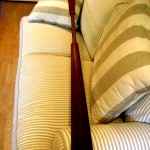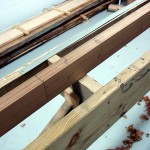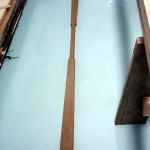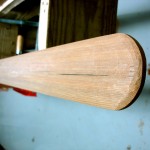Happy Birthday Evan!
 Evan is a kayaker. When he learned that I was getting serious about boatbuilding and building a collection of woodworking tools, he said something like, “It sure would be nice to have a Greenland paddle. Now that you have tools…”
Evan is a kayaker. When he learned that I was getting serious about boatbuilding and building a collection of woodworking tools, he said something like, “It sure would be nice to have a Greenland paddle. Now that you have tools…”
I’ve never used one, but I have learned that Greenland paddles are very lightweight paddles and are very efficient when properly used. Never one to jump into something without sufficient research, I found many resources on the internet about making these paddles. Perhaps the best, and most often referenced, is Chuck Holst’s “Making a West Greenland Paddle” (PDF file). I also used a step-by-step book, “Greenland Paddles,” by Brian Nystrom. Redundancy: belts and suspenders. It turns out that both are very similar and either will do just fine.
Chuck Holst suggests making your first paddle from inexpensive construction lumber. He must be located in a place where spruce construction lumber is readily available. Not here! We have Douglas Fir which is 50% heavier and a 1000% uglier. I looked for Sitka spruce while on a lumber shopping trip recently, but they did not have stock that was thick enough. I settled for Western Red Cedar which is one of the woods that Brian Nystrom suggests. It is indeed lightweight, somewhat lighter than spruce and half the weight of the ugly doug fir. Along with the lightness comes softness, a tradeoff in durability. The stuff takes dents and dings very easily.
 Shaping the paddle is quick and easy work. In fact, it took about as much time to layout the lines as it did to work the wood. Being the first time I’ve made one of these, I very carefully laid out all the lines before picking up any shaping tools. I think it an essential exercise in fully realizing the shape of the thing. For example, it’s not immediately obvious that the oval of the loom is orthogonal to the oval of the blades. Get this wrong and the paddle will probably feel very strange in the hands.
Shaping the paddle is quick and easy work. In fact, it took about as much time to layout the lines as it did to work the wood. Being the first time I’ve made one of these, I very carefully laid out all the lines before picking up any shaping tools. I think it an essential exercise in fully realizing the shape of the thing. For example, it’s not immediately obvious that the oval of the loom is orthogonal to the oval of the blades. Get this wrong and the paddle will probably feel very strange in the hands.
 So, immediately after very precisely marking a jillion lines, the first few passes of a spokeshave removes about half of them! That’s OK. The important thing is to hang onto the center lines. Everything else can be reconstructed from them.
So, immediately after very precisely marking a jillion lines, the first few passes of a spokeshave removes about half of them! That’s OK. The important thing is to hang onto the center lines. Everything else can be reconstructed from them.
The tool I used most for shaping is a Stanley #51 spokeshave that’s been around since about 1920. I selected this piece of cedar for the straightness and evenness of its grain. Working it was absolutely delightful. Smooth and easy. It was so easy to work that I needed very little sanding.
The only difficulty, and a relatively minor one at that, was figuring out how to keep the workpiece immovable without undue clamping pressure leaving marks. A lot of the work was done with the loom (relatively flat surface) clamped to my bench and the ends hanging free. In July this year, I spent about half an hour in the doorway of Saverio Pastor’s workshop watching him shape a remo (oar). Saverio is Venice’s master remer. He is an artisan who crafts remi (oars, plural of remo) and forcole (plural of forcola) the multi-faceted multi-pivot post used for rowing Venetian boats. If I were in the business of making more oars and paddles, I would use Saverio’s work holding techniques. He uses a vice which looks like the leg vise of a cabinet maker’s workbench to hold one end of the workpiece. It looks a bit strange to see this vice simply planted in a hole in his workshop floor, seen just under his right elbow in this photo. The other end of the workpiece floats loosely in a tree like extension from a horse that can be easily moved about, seen in the left of the previous photo and more closely in this photo. While peculiar to his art, these are very efficient ways to hold and manipulate the workpiece.
I made a couple of decisions along the way. Here’s where experience with this sort of paddle would help. Having none, I went with what I thought reasonable.
 Blade thickness, measured at the tip, is a balance between performance and durability. I ran the tips down to about 3/8″ before final smoothing. This is the thickness Holst recommends, but is thinner than what Nystrom suggests for a first paddle. Others suggest even thinner, but I can imagine anything thinner getting pretty easily beat up, especially if you use the paddle to push off in rocky areas.
Blade thickness, measured at the tip, is a balance between performance and durability. I ran the tips down to about 3/8″ before final smoothing. This is the thickness Holst recommends, but is thinner than what Nystrom suggests for a first paddle. Others suggest even thinner, but I can imagine anything thinner getting pretty easily beat up, especially if you use the paddle to push off in rocky areas.- I left distinct facets on the loom. The loom is eight sided, and each is distinct on this paddle. It could be smoothed into a constantly smoothed oval, but I opted for leaving the edges of each face as an aid to orienting the paddle in the hands. The same with the blade shoulders. They are faired a bit, but not as much as they could be. This is a starting point and intended as an aid to someone beginning to use this kind of paddle. Maybe an experienced Greenland paddler would prefer more organic shapes. If so, it can still be done. Start with some 80 grit sandpaper and reshape it.
To help durability a little, I coated the last few inches of the blade ends with two coats of West System epoxy. That should provide a little bit of wear resistance without adding significant weight. The remainder of the finishing used pure Tung oil, pure stuff, not the imitations found in the home center stores. The first two coats were thinned with mineral spirits. Then, 3 more coats were hand rubbed and allowed to dry completely between each coat. This finish won’t make the paddle impervious to water, but will make it somewhat resistant and keep the wood from soaking up and getting heavier. Annual renewal of the coating is a good thing to consider.
It was a very enjoyable project. Maybe Evan will tell us how the paddle works out. (The lakes in Minnesota haven’t frozen yet.)
Leave a Reply